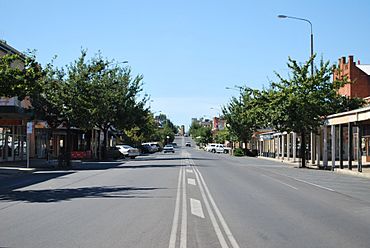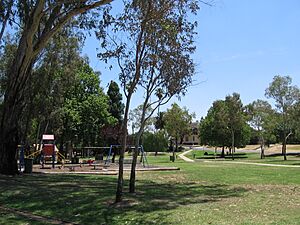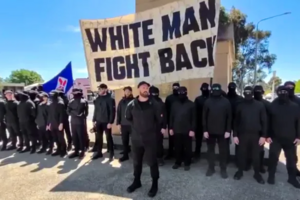Corowa facts for kids
Quick facts for kids CorowaNew South Wales |
|||||||||
|---|---|---|---|---|---|---|---|---|---|

A view of the main street of Corowa
|
|||||||||
| Population | 5,595 (2021 census) | ||||||||
| Established | 1858 | ||||||||
| Postcode(s) | 2646 | ||||||||
| Elevation | 143 m (469 ft) | ||||||||
| Location | |||||||||
| LGA(s) | Federation Council | ||||||||
| County | Hume | ||||||||
| State electorate(s) | Albury | ||||||||
| Federal Division(s) | Farrer | ||||||||
|
|||||||||
Corowa /ˈkɒrəwə/ is a town in the state of New South Wales in Australia. It is on the bank of the Murray River, the border between New South Wales and Victoria, opposite the Victorian town of Wahgunyah. It is the largest town in the Federation Council and was the administrative centre of the former Corowa Shire. The name could have derived from an Aboriginal word referring to the curra pine which yielded gum used by Aboriginal people to fasten the heads of spears to the shafts. Another translation is "rocky river".
There are two bridges over the Murray to Wahgunyah in Victoria: the heritage-listed John Foord Bridge and the Federation Bridge (opened on 2 April 2005). The town in conjunction with nearby town Rutherglen has an Australian Rules football team (Corowa-Rutherglen), competing in the Ovens & Murray Football League, and a rugby league team, the Corowa Cougars, who compete in the Goulburn Murray competition.
Contents
History
Bangerang
The Aboriginal people from the area are the Bangarang people.
The tribe of Indigenous Australians that inhabited the Corowa area were called, in their own language, the Bangerang Tribe. The name has various spellings in English, varying all the way from Bandjalang through Panderang to Pinegorine.
Foord's punt
John Foord (c. 1820 – 15 February 1883) "The Emperor of Wahgunyah", settled on the Murray River near the Ovens junction (on the southern side of the river) in the early 1840s. In about 1843 Foord and a man named Bould examined the country about the present site of Wahgunyah and recommended it to John Crisp, who was the first European to settle in the area. Later Crisp sold his land to John Foord. With the development of steamer transport on the Murray River in the mid-1850s, Foord purchased a punt which was brought up to Wahgunyah by the steamer Leichhardt. Foord built two extensive warehouses which he let to river navigation companies. Traffic was attracted to Foord's punt, leading to the establishment of Corowa township, opposite to Wahgunyah. In October 1892, the Corowa railway line opened from Culcairn. It closed in January 1989.
Township development

Land was surveyed in 1857 at Corowa by Surveyor Adams and the next year the township was proclaimed. In September 1859 a meeting was held to consider the erection of a bridge between Wahgunyah and Corowa to replace the punt. Construction of a bridge was commenced early in 1861 and the completed structure cost about £8,000. The bridge construction was probably privately funded.
Corowa Post Office opened on 1 January 1861.
In 1861 an Anglican church was built at Corowa on land donated by John Foord.
It was reported in 1868 that Corowa "was fast becoming one of the most important of the border districts". Buildings erected that year included a new store, two hotels and a new court-house.
A branch of the Bank of New South Wales was established in a new brick structure at Corowa in 1874. The building of a Roman Catholic church commenced in September 1874. A report in 1875 stated that Corowa as a township "was making rapid strides". The township had a total of seven hotels. A "private township" had been laid out at Corowa on land formerly owned by Sanger and Foord, with the land selling at £80 to £100 per acre. The Government township, laid out about two miles from the river, was deemed a failure.
A report published in The Sydney Mail in October 1879 stated that Corowa township consisted of one thoroughfare containing the business houses. On a nearby hill the residences of the wealthier residents had been erected. It was claimed that the Government town of Corowa, two miles from the river, was "a vast wilderness". It was postulated that the reason for the failure of this township to develop was the fact that only one approach to the bridge from that point could be obtained. The toll for crossing the bridge was said to be "somewhat exorbitant," and prevented free intercourse between Corowa and Wahgunyah.
Later developments
In 1882 the bridge between Corowa and Wahgunyah was purchased by the New South Wales Government.
A Presbyterian church and an Oddfellows' Hall were built at Corowa in 1886.
In the 1890s, Corowa was the site of several important conferences leading to the federation of the various colonies into the Commonwealth of Australia in 1901.
Gold mining
A large but spectacularly unsuccessful gold mine, the Corowa Deep Lead Mine, was located just to the north of the town.
There were gold deposits and many gold mines at Rutherglen, on the Victorian side of the border. A working hypothesis was that the gold deposits extended, under the Murray and the inter-colonial border, to Corowa. In 1893, a company was formed to explore the area, by sinking bore holes looking for alluvial gold in a deep lead deposit. By late 1894, gold bearing gravel was struck at a depth of 307 feet.
A new company, Corowa Deep Lead Gold Mining & Prospecting Company No Liability was floated, and work began on the mine in 1897, at a time when the New South Wales Government was attempting to increase gold production in the colony. Its construction was subsidised by the N.S.W. Department of Mines.
Two shafts were sunk. No.2 shaft reached the bottom, by the end of 1898, but only with difficulty due to the pressure of subterranean water encountered. By mid-1899, pumping of water from No.2 Shaft had allowed No.1 Shaft to be sunk more readily, and the subsidy paid by the Mines Department had been increased from £2 to £4 10 per foot of shaft sunk. A proposal to float the venture as an English company in London was defeated on a vote of shareholders. By the end of 1899, No.1 shaft had also reached the bottom at 386 feet. Pumps removed a colossal amount of water from the mine, over 750,000 gallons per day. Cutting drives out from the shaft to the bore sites proved difficult, due to the hard rock encountered. It was necessary to cut through bedrock so that the groundwater in the gold-bearing "wash" could be drained, via a geologically stable route, and pumped away, prior to extracting the wash. The gold-bearing wash had still not been reached by mid 1901.
Small amounts of gold were produced, by mid 1902, but shareholders were told that there would be more capital needing to be raised to make the mine payable. An optimistic newspaper report, of October 1902, pronounced the mine operations a success, also carrying photographs of the miners, the directors, and the two headframes of the mine. With its capital being exhausted, before reaching the wash, the failure of the pumping engine's crankshaft dashed the hopes of long-suffering shareholders. By early 1903, the company had been reconstructed, apparently with an injection of capital from English shareholders, and new machinery was being erected. By September 1904, miners were on wash but it was "rather wet" and not payable. By late 1904, the company again needed additional capital, and a decision was taken that it would be wound up. It had sold 2,033 ounces of gold, from April to November 1904, but costs took much of the revenue; the balance sheet of the company was, by then, only £100 in surplus. The directors were authorised to put the company and all its assets up for sale. The liabilities were discharged, and the company was wound up in 1905.
Neo-Nazi rally
On Saturday 12 October 2024, roughly 50 members of the National Socialist Network lead by Thomas Sewell rallied in the town's centre as a response to a local piggery's takeover by multinational meat processor JBS. The group displayed a banner reading "White Man Fight Back" due to JBS's employment of immigrant workers. Police dispersed the group with no arrests being made.
Heritage listings
Corowa has a number of heritage-listed sites, including:
- 8 Church Street: Corowa Courthouse
- Culcairn-Corowa railway: Corowa railway station
- Steel Street: Corowa Flour Mill
| Historical population | ||
|---|---|---|
| Year | Pop. | ±% |
| 1921 | 2,387 | — |
| 1933 | 2,757 | +15.5% |
| 1947 | 2,751 | −0.2% |
| 1954 | 3,045 | +10.7% |
| 1961 | 2,593 | −14.8% |
| 1966 | 2,709 | +4.5% |
| 1971 | 2,923 | +7.9% |
| 1976 | 3,031 | +3.7% |
| 1981 | 3,390 | +11.8% |
| 1986 | 4,315 | +27.3% |
| 1991 | 5,064 | +17.4% |
| 1996 | 5,785 | +14.2% |
| 2001 | 5,208 | −10.0% |
| 2006 | 5,628 | +8.1% |
| 2011 | 5,450 | −3.2% |
| 2016 | 5,337 | −2.1% |
| 2021 | 5,444 | +2.0% |
| Source: Australian Bureau of Statistics data. | ||
Climate
Corowa has a temperate humid subtropical climate (Cfa) with hot, mostly dry summers and cool wetter winters.
| Climate data for Corowa Airport (1907–2022, rainfall to 1890); 143 metres or 469 feet AMSL; 35.99° S, 146.36° E | |||||||||||||
|---|---|---|---|---|---|---|---|---|---|---|---|---|---|
| Month | Jan | Feb | Mar | Apr | May | Jun | Jul | Aug | Sep | Oct | Nov | Dec | Year |
| Record high °C (°F) | 46.0 (114.8) |
46.0 (114.8) |
40.5 (104.9) |
34.0 (93.2) |
28.4 (83.1) |
23.0 (73.4) |
20.0 (68.0) |
26.3 (79.3) |
33.5 (92.3) |
36.0 (96.8) |
42.5 (108.5) |
42.5 (108.5) |
46.0 (114.8) |
| Mean daily maximum °C (°F) | 31.9 (89.4) |
31.3 (88.3) |
27.9 (82.2) |
22.5 (72.5) |
17.8 (64.0) |
13.9 (57.0) |
13.1 (55.6) |
15.0 (59.0) |
18.5 (65.3) |
22.2 (72.0) |
26.6 (79.9) |
30.1 (86.2) |
22.6 (72.7) |
| Mean daily minimum °C (°F) | 15.7 (60.3) |
15.7 (60.3) |
12.7 (54.9) |
8.6 (47.5) |
5.6 (42.1) |
3.6 (38.5) |
2.8 (37.0) |
3.7 (38.7) |
5.7 (42.3) |
8.1 (46.6) |
11.1 (52.0) |
13.6 (56.5) |
8.9 (48.0) |
| Record low °C (°F) | 5.0 (41.0) |
6.0 (42.8) |
3.9 (39.0) |
0.0 (32.0) |
−4.5 (23.9) |
−5.0 (23.0) |
−4.5 (23.9) |
−5.0 (23.0) |
−2.0 (28.4) |
0.0 (32.0) |
0.4 (32.7) |
3.7 (38.7) |
−5.0 (23.0) |
| Average precipitation mm (inches) | 36.4 (1.43) |
37.4 (1.47) |
38.0 (1.50) |
36.3 (1.43) |
46.6 (1.83) |
56.0 (2.20) |
54.9 (2.16) |
53.3 (2.10) |
48.2 (1.90) |
51.8 (2.04) |
41.7 (1.64) |
40.9 (1.61) |
541.2 (21.31) |
| Average precipitation days | 4.3 | 3.9 | 4.6 | 5.7 | 8.0 | 10.3 | 11.6 | 11.4 | 9.0 | 8.3 | 6.2 | 5.3 | 88.6 |
| Average afternoon relative humidity (%) | 32 | 33 | 36 | 44 | 56 | 67 | 68 | 60 | 55 | 46 | 38 | 33 | 47 |
Prominent people
- Taylor Duryea - Australian rules footballer
- Ryan Garthwaite - Australian rules footballer
- Sam Groth – Australian tennis player
- Charles Raymond Gurney – Australian aviator and WW2 pilot, born in Corowa
- John Howard – Actor born in Corowa
- Nigel Lappin – Australian rules football player born in Corowa
- John Longmire – Retired Australian rules football player, played for North Melbourne Football Club from 1988 to 1999, coach of Sydney Swans since 2011
- Ben Mathews – Australian rules football played for Sydney Swans from 1997 to 2008
- Stephen Mowlam – Australian field hockey player who grew up in, and played hockey for Corowa
- Joey Palmer – Cricketer in the 1880s born in Corowa
- Cathy Svarc – AFLW player
- Ruby Svarc – AFLW player
- Blake Pavey – Comedian born in Corowa
- Mike Walsh – Television host



